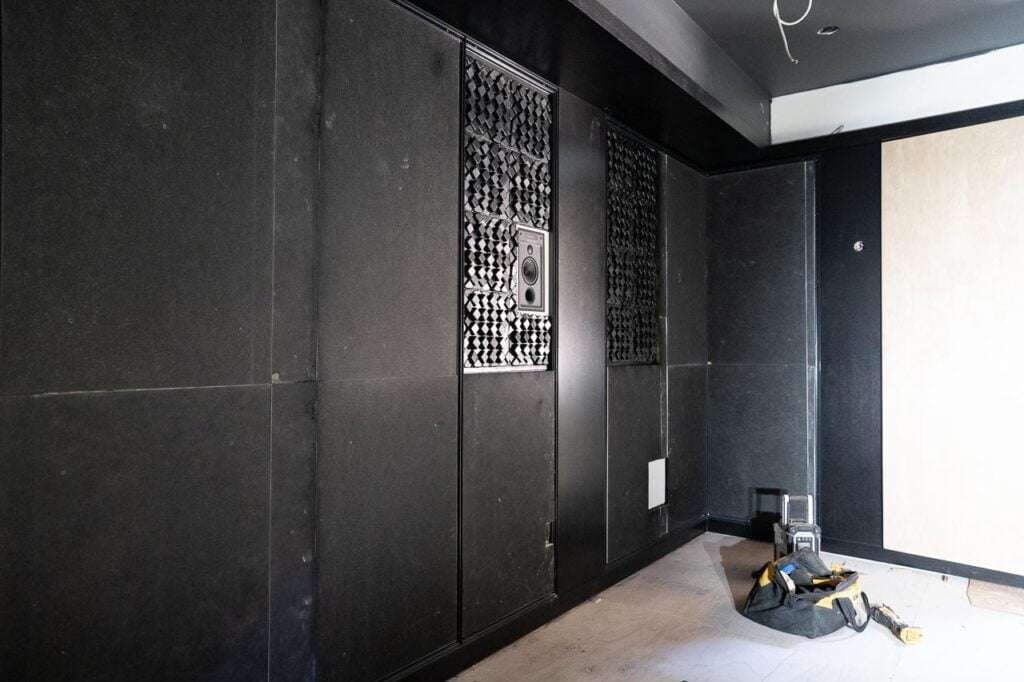
There is a common misconception that sound isolation and acoustical treatments are the same. In actually, they serve two different purposes. Acoustical treatments are most commonly used for dedicated home theaters and listening rooms. They are great tools for minimizing echoes and making the room sound great. Sound Isolation is what we do to isolate sound between media spaces, bedrooms and common areas. In fact, we can’t imagine working in busy home without some form of sound isolation!
Sound Isolation:
Sound isolation keeps the sound in a room from spilling into other areas and prevents external sounds from getting in. If one person wants to play an instrument in one room, a well-isolated room will prevent it from being heard from a neighboring room. They are especially great when used in between floors. Bedrooms are typically on the upper floors, while common areas are generally on the first floor. There are three main ways we isolate a room.
Seal The Room
We can have six-inch thick concrete walls, but if we have a 1″ wide hole through it, the sound is going to travel through it easily. In practice, the “holes” in a room include the gaps around the door, heating vents, outlets, switches and light fixtures. The lack of a complete seal allows sound to “bypass” all our efforts to contain the sound in a room. So we have to seal off all those peripherals. The light cans, outlets, HVAC vents, in-ceiling speakers and doors must be completely sealed. Using gaskets, backboxes, caulking or some other form of sealant ensures the room is sound-tight.
Adding Mass
The more material we add to the walls or ceiling of a room, the more difficult it is for sound to pass through it. Imagine trying to yell through a sheet of paper compared to a ream of paper. In practice, we add mass by adding more material into the walls. For example, we like to add a second layer of sheetrock over a standard single layer of sheetrock to increase the mass in the walls. We also like to add rockwool insulation in the wall to absorb sound.
Decoupling A Space
The final method we use is space decoupling. Decoupling is the process of isolating a room’s structure from the structure of the neighboring rooms. If two rooms share a wall, the sound from one room can vibrate the shared wall and bring it into the other. The amount of mass in the wall dictates how loud that passing sound would be. By decoupling the rooms with space in the middle, the sound coming through the wall can dissipate before entering any neighboring rooms and vice versa.

Decoupling With Double Stud Walls
There are various ways to decouple a room depending on budget and space constraints. The most effective way is with a double stud wall. A traditional room has a wall made of drywall that is screwed into studs that are the room’s framing. In a non-decoupled space, the drywall of two neighboring rooms are attached to the same stud. In this setup, the sound will vibrate the drywall, pass through the stud and then into the neighboring room’s drywall. A double studded wall is when each room gets its own studs and insulation. None of the studs are touching, preventing sound from passing through the wall as easily.
Decoupling With Staggered Studs
The next method is a staggered stud wall. This is similar to the double stud wall, as both rooms have their own set of studs not touching the neighboring room. However, the studs of one room are staggered so that they can be placed closer to the drywall of the neighboring wall. It is much more space efficient but slightly less effective than a double stud wall.


Decoupling with Hat Channels
The final and most space-efficient method is a hat channel decoupled wall. This example is close to a traditional wall: There is only one set of studs, and one wall’s drywall is bolted directly to the stud, but the big difference here is that the adjacent wall’s drywall is attached to a steel bar (hat channel) which is mounted to the studs through a sound-absorbing whisper clip. The whisper clip acts like a “shock absorber” of sorts. If sound tries to transmit through the walls, the whisper clip absorbs most of the vibration and acts as a noise dampener. Unfortunately, a noise dampener is only resistant to some sounds, making it the least effective of the decoupling methods.
Acoustical Treatment:

Acoustical treatments make the sound inside the room sound its best. We improve the room’s acoustics by minimizing unwanted reflections and long-decay sound waves.
Unwanted Reflections
Unwanted reflections are sounds that bounce off solid surfaces. Generally, we want to hear music only from the source, like a speaker. Sound moves at a constant rate of speed. If you stand 10 feet from a speaker, an unwanted reflection may be a sound wave from that same speaker that bounces off the wall and then returns to you, traveling a net distance of 14 feet. The end result is two sound waves arriving at your ear at nearly the same time but are heard by you at slightly different times. This phenomenon is what makes audio sound “muddy” and not crisp.
Long Decay Sound Waves
Long decay sound waves are echoes. These waves bounce off two reflective (read: hard) surfaces and don’t get a chance to decrease in volume. It sounds like a bunch of echos on top of each other in rapid succession. Acoustical treatments absorb or scatter these reflective sounds to ensure these echoes are mitigated before they can be heard.
Acoustical solutions can vary greatly. First, we recommend to look closely at the design of the room.
Methods of Acoustical Treatment
We combat unwanted sounds in two ways: absorption and dispersion. Absorbing materials can absorb unwanted sounds and prevent them from continuing to travel in a room. However, a dispersion panel can take a concentrated “loud” sound and spread it out into a tiny sounds in various directions. A better way to visualize this is to imagine throwing a snowball against a wall. The initial velocity of the snowball is fast. As the snowball hits the wall, it breaks into a ton of small pieces that move in several directions at a much slower speed than the initial throw.
Is There Such a Thing As Too Much Acoustical Treatment?
The placement and density of these acoustical treatments require engineering to make them work optimally. Too much acoustical treatment can create a “dead room,” which is when an unnaturally low amount of sound reflections make us feel uncomfortable. We have to consider the room’s size and layout to create the ideal solution to minimize unwanted reflections and still remain comfortable. There are a lot of natural forms of acoustic treatments. Objects like heavy drapes, floor coverings and soft furniture are natural absorbers, while objects like bookshelves are great for dispersing sound. Before you decide to get acoustical treatments, it’s always a good idea to think about using design to mitigate unwanted sounds.
Which Is Best, Isolation or Acoustical Treatments?
The truth is it depends! Sound isolation gives you privacy between all your spaces. Play a movie in one room and work in another without either person being interrupted. If you want the quality of the sound in a room to be its best, such as with instruments and media systems, then acoustical treatments will get you the best quality sound. However, you’ll need both if you want good quality sound and you want to keep that sound from bothering others as well as keep unwanted external sound from getting in.
If you’re unsure which is best for you, feel free to call us at 415-456-7000 or send us a message through our website.

